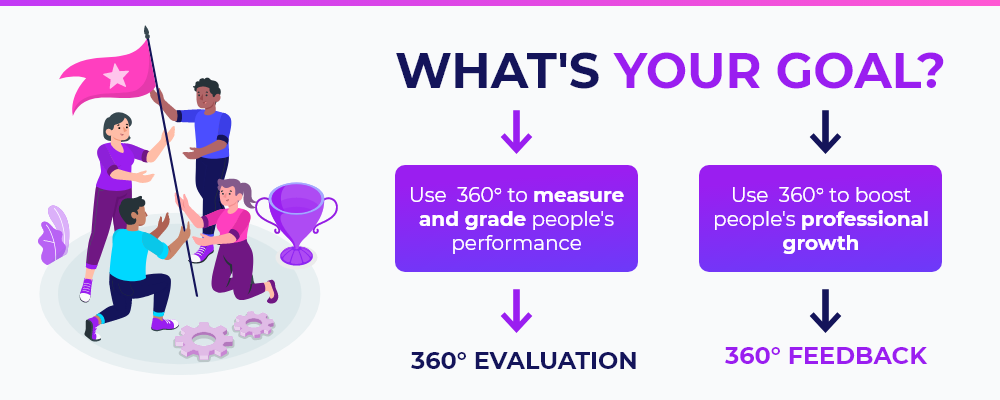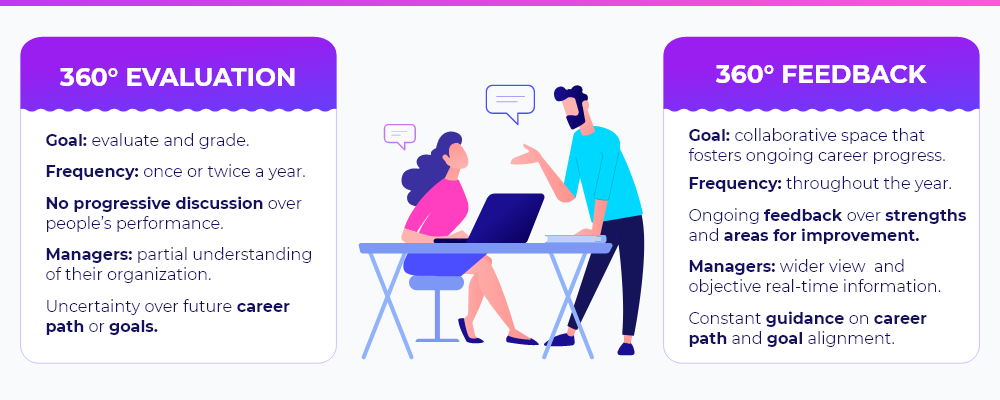360° feedback: the next step your organization should take
Written by: María Eugenia Raffaele
“We all need people who will give us feedback. That’s how we improve.” – Bill Gates
Especially in today’s scenario, ongoing 360° feedback can be the answer organizations need to transform their management communication, and encourage employees to grow to their full potential on the pillars of confidence and trust.
Throughout time, organizations have used different methods to evaluate employees’ performance with the sake of identifying areas of improvement and determining whether their skills appropriately matched their job. Traditionally, employees used to be evaluated only from their direct managers – this was a limited and subjective activity which resulted in little or no professional growth. Luckily, many organizations have gradually left 1:1 traditional methods behind, and now choose 360° systems that give HR the chance to get a wider and more holistic perspective of every employee, with information coming from different people and areas across the company.

Now, here’s an important point to highlight: although 360° systems are more efficient than traditional ones, the results obtained and the overall impact on employees will mostly depend on the way performance management is approached in every organization. Today, while some companies use 360° evaluations to measure and grade their employees, others take professional development to the next level: they create a space of collaborative ongoing 360° feedback, where everyone can grow professionally and feel valued.
So, what ‘s best? 360° evaluation or 360° feedback?
If you operate a business and are looking for an appropriate method to get insight on every employee and optimize their experience and results, you might need to ask yourself the following question: What’s my goal? Do I seek to merely measure and rate my employees’ work, or do I want to be part of their ongoing professional growth where expectations are clear and confidence is part of the day-to-day experience? Your answer will take you to 2 markably different destinations.

360° evaluation
To put it simply, 360° evaluation is a tool that gives each employee the possibility to receive a score for their performance and achievements based on differing perceptions across the company. As any evaluation – regardless of whether it’s 360 ° or not, this is a formal procedure through which companies grade or score employees based on fixed rating scales.
Now, if the organization’s aim is to achieve significant growth and development of their workforce, a 360° evaluation as an end in itself is limited. Given the fact that they require more planning and training to ensure a consistent process, they are generally carried out once or twice a year, which represents several challenges for the organization:
- Leaders miss the chance to discuss and tackle issues cooperatively with the employee early on and progressively.
- Managers get partial understanding of their organizational dynamics.
- If there isn’t a solid culture with strong connections among people, receiving reviews from different sources can be overwhelming for the employee, leading to a decrease in engagement and productivity.
- If communication and collaborative feedback are not part of the organization’s day-to-day experience, 360° reviews can be subjective and create mistrust, or conflicts among people.
- 360° performance reviews might not reflect the strengths and areas for improvement clearly to the employee. Therefore, the path to their future becomes muddled: they will not know where to direct their efforts and will not feel valued or truly part of the organizational culture.
- It becomes more complex for leaders to obtain concrete and representative data throughout time. This can cause lack of continuity with regard to employees’ future career paths.
- Goals are not mapped or clear, which generates uncertainty and results in an employee with little self-confidence and/or commitment towards the company.
In general terms, although 360° evaluations aim at providing a more balanced view of every employee, they are formal and infrequent procedures that represent limitations and challenges for the culture of the company – especially when trust and fluent communication are not part of everyone’s day-to-day experience.
360° feedback: A step forward
Still nowadays, giving and receiving feedback seems to be one of the main challenges for managers, since only 26% of people claim they find it actually useful.

360° feedback is capable of so much more than just evaluating the employee. It is a method that brings the feedback process full circle. Not only does it boost people’s career paths and improvement, but also creates an engaging and pleasurable working environment.
360° feedback is definitely not the same as a 360° annual review – it’s an ongoing process that involves everyone in the company and makes people feel more valued and visible. When combined with effective communication and relationships based on trust, people look forward to giving and receiving 360° feedback from peers and leaders across the organization because it’s already part of their everyday experience.
360° feedback also allows HR to obtain real-time data and a more objective vision of the progress their teams are making. This is a valuable opportunity for them to hold frequent one-on-one meetings where they go over feedback together, align goals, and empower employees by giving them a voice and objective guidance.

To put it simple, feedback is key to enhance relationships, remain aligned, and create strategies for constant improvement.
StarMeUp, for example, is a digital solution that companies choose when they want to articulate their cultural strategies with an efficient 360° feedback platform that promotes constant professional development powered by people analytics. Leaders can set and align goals, conduct evaluations, and provide objective feedback all the year through. Plus, counting with multiple leaders enhances a collaborative culture and optimizes people’s experience because all leaders can evaluate team members and gain deeper understanding of their work and goals.
Especially in times of remote leadership, promoting continuous learning, authentic collaboration and self-awareness in all your employees can represent a great challenge, but it’s possible to achieve this through the implementation of efficient 360° feedback. It all depends on the path you choose to take.
If you still have doubts on the best way to bring about growth, team development and individual improvement this 2021, our group of specialists can guide you through, taking into account your objectives and organizational culture. Tell us what you need, and let’s make it happen!